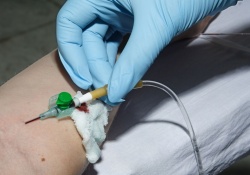Who benefits from a catheter - and who does not?
A new detailed guide gives doctors and nurses information to help decide which hospital patients may benefit from a urinary catheter - and which ones do not. That should help spare patients the pain, embarrassment, and potentially serious side effects that can come with having a catheter placed - which may bring more risk than benefit to the patient.

Called the Ann Arbor Criteria for Urinary Catheter Appropriateness, published in the Annals of Internal Medicine as a special supplement, this guideline provides far more detailed advice than ever before.
Many hospitals currently use a short list of appropriate and inappropriate urinary catheter uses published by the Centers for Disease Control and Prevention in 2009. Unlike this guideline, the new one includes criteria for choosing between three urinary catheter types: indwelling Foley catheters, which continuously drain the bladder, in-and-out catheters, and external "condom" catheters for men. It also points to when non-catheter strategies may be better, and addresses common and practical bedside challenges that arise, such as managing incontinence in patients who are very difficult to turn.
"In general, because urinary catheters increase the patient's risk of infection and other complications such as pain and scarring of the urinary tract, they should only be used when teams have no other way to assess a patient's urine or fluid status," says Jennifer Meddings, M.D., M.Sc., lead author of the paper and an assistant professor of internal medicine at the U-M Medical School. One in five hospital patients receives a Foley catheter - but the new Ann Arbor Criteria suggest that far fewer should.
For instance, the guide says that Foley catheters should not be placed routinely for all intensive care unit patients. Although many ICU patients need hourly urine volume measurement, which requires an indwelling catheter like a Foley, other patients could be managed with a different strategy. Or they could at least have the catheter removed sooner in their ICU stay, after stabilization. Each day of catheterization increases the risk of complications. So even one day less of catheter use could make the difference in protecting a patient against infection - especially because many UTIs acquired during hospitalization are resistant to antibiotics.
"Reducing the use of catheters, and the UTIs, bloodstream infections and urological emergencies that can arise from their use, could reduce hospital costs," says co-author and longtime urinary catheter researcher Sanjay Saint, M.D., M.P.H., Chief of Medicine at the VA Ann Arbor Healthcare System and the George Dock professor of internal medicine at the U-M Medical School. He points to results from an effort that has involved half of all hospitals in the state of Michigan, run by the Keystone Center for Patient Safety. Through a number of catheter-related tactics, it reduces catheter use and catheter-associated UTIs by 25 percent - during a time when rates in other states decreased far more slowly despite federal-level efforts to drive them down.
Now, that same approach - called the "Bladder Bundle" - is being used in nearly 1,000 hospitals nationwide as part of the "On the CUSP: Stop CAUTI" initiative sponsored by the Agency for Healthcare Research and Quality. Soon, those hospitals will begin using the Ann Arbor Criteria to guide their catheter use.
Saint and Meddings, and their U-M and VA Ann Arbor Healthcare System colleagues, also run a website called CatheterOut.org that offers free information and resources for hospital teams on all aspects of catheter use. The new criteria will be available there as well. "Our past research has shown that a third to a half of the days that patients have indwelling catheters are unnecessary." says Saint. "We would very much like these new criteria to be used nationwide by every care team, to determine when a Foley catheter is appropriate."
Source: University of Michigan Health System
12.05.2015






